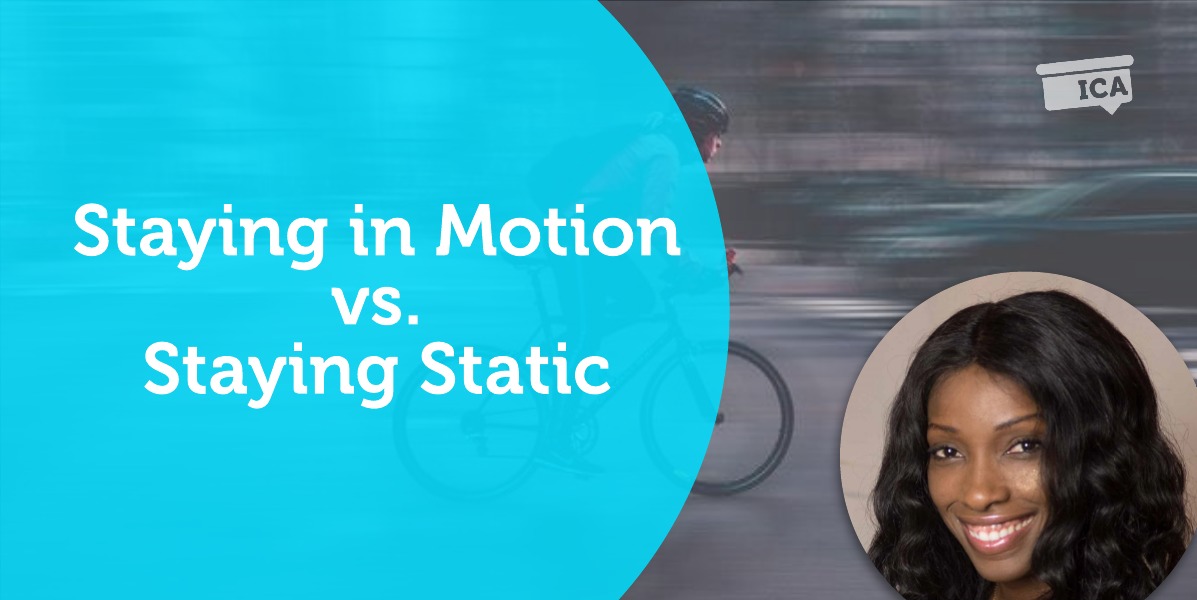A Coaching Power Tool Created by Shauna Vassell
(Leadership and Career Coach, CANADA)
Spurts of transformational change are generally triggered by an event, not typically willingly. Working with a lot of clients, the pattern that you see is, it’s easier to lay in a state of equilibrium where comfort trumps being in motion. Most of the time, this is where the feeling of being stuck surfaces.
The recurring theme that gets in the way of achieving goals is generally the beliefs. Beliefs can keep you in a static state to a point of misalignment creating the inability to see past your own perceptions or views. Progress requires motion, as what we did today, may no longer be relevant tomorrow.
Belief, according to Dictionary.com, is,
an acceptance that a statement is true or that something exists.
This power tool is intended to give a greater awareness of what stage we are in and what is causing us to stay there, so we can act.
Static:
Static is referred to, according to Hudson (2008), as a stage where we live between eras in which we once had a sense of stability and dependable work fields that have now evolved into a continuous change driven state. (p.1)
He goes on to say, there are four old rules: linear, steady-state, outside-in and the learning rule (p.7-9). Each of the rules mirrored a static state of consistency. As a coach our clients come to us when there is misalignment with that steady-state and the force of change that is approaching or already there, brings discomfort.
When we are in a static state, there is little or no change. It is also termed as, “lacking movement… or vitality” (Dictionary.com). In coaching, awareness brings the “aha” moment to the client where there is this misalignment.
Then the question becomes, how can we transform our clients and take them to the next state?
Staying in Motion:
If you are not in motion, you are static. The opposite of static is being in motion, where we embrace change. In the present, we identify what is in our control and release what is not and where necessary, set boundaries. Motion according to dictonary.com, means, “the action or process of moving or of change place or position.” It also refers to the definition as, “power of movement, as of a living body”
When clients feel they need to change but struggle to do so, this is generally because of fear, or insecurity.
It’s the, “what ifs”, “the maybe later”, “the after I…”, “because I can’t…”, “I could never…”, “I just don’t…”.
Breaking the static
We develop these beliefs throughout our lives. Therefore, to shift a client’s inherent belief we need to get out of being static and having static thoughts. The most powerful perspective that can be applied to almost any challenging experience is to challenge one’s limits and create opportunities for being in motion.
Coaching Application:
Jill has been an employee with company ZBR, where she spent the last 15 years in the same role she started in. She is ambitious, worked hard, but felt it was never time to move on, even though she felt slighted by the company, and didn’t see any real growth. Over the years, she has trained several interns, students, who have become her bosses, colleagues, superiors and watched them grow from her tutelage.
What would life be if we had no courage to attempt anything? – Vincent Van Gogh
We would be static!
Static:
On numerous occasions, Jill was offered new roles higher than the one she had and declined them. Some of these roles lined up with her growth plan, but Jill turned it down, stating, “she would have to relocate desks and it would be disruptive to the team and the organization if her knowledge was no longer there.” Jill refused both coaching and mentoring to help her develop and prepare for the change. Why did Jill refuse? Jill had raging emotions on what the changes would mean for her. How she will perform? And if she would fail? She was an expert! Her insecurities of not being the expert in the new role, made her resist the change and revert to her steady normalcy – static state. The state she knew.
Growth is painful. Change is painful. But nothing is as painful as staying stuck somewhere you don’t belong – Unknown
Source: Stevencox.com
In Motion:
After 14 years in the job, Jill’s company was bought out and restructured – the trigger for change. Jill was moved and shifted to a new role and she had to adapt. She was no longer the expert, but as she rode the wave, being in motion wasn’t as bad as she thought it would be. She didn’t need to be the expert, only to know the right questions to ask her new team. With the help of her coach, Jill reflected on being in a static state and realized that she could have been in this role years earlier on her own terms, with the support that she needed.
Reflection:
What changed for Jill? Her situation, but also her view on what “static state” meant. She realized all the things she thought would happen, wasn’t so bad after all. It was manageable and wasn’t as hard as she initially thought. In steady-state, she knew the role but had no control of whether the role would be there or not. Staying the same she wasn’t exposed to new people, her new team, new challenges, that she now realized she loved, she grew.
What was Jill’s self-awareness? Jill had limited herself by fearing to fail, being insecure and having a lack of confidence in her abilities. If Jill had been in motion, this change would not have caught her off guard and forced her to adapt.
Application:
When clients go into the static mode, using techniques such as visualization can bring clarity to the fears and allow them to challenge their beliefs. Allowing Jill to identify what is in her control and what was getting in the way served as an important step throughout the self-awareness. During the state of being and feeling static Jill needed to feel supported and encouraged to take “safe” steps towards action. Asking powerful questions can be a great way to help clients make the shift to see what’s in their control and what is holding them back.
Some questions we can use to shift from staying static to staying in motion are:
- Where are you now?
- What are you giving up, to stay where you are?
- What is keeping you here?
- What does taking action mean to you?
- What is important?
- How is being “here” working or not working for you?
- What is the ideal state? What is challenging for you to get to the ideal state?
- How do you know when you are there? And what would we need to keep you there?
To progress requires change – Unknown
Source:
The International Journal of Coaching in Organizations. The context of coaching. Frederic Hudson. 2008. Taken from ICF federation. Research portal. www.ijco.info. pg. 1- 29. Accessed, June 2019.
Dictionary.com. Belief definition. https://www.dictionary.com/browse/belief. Static definition: https://www.dictionary.com/browse/static?s=t. Motion definition. https://www.dictionary.com/browse/motion?s=t

